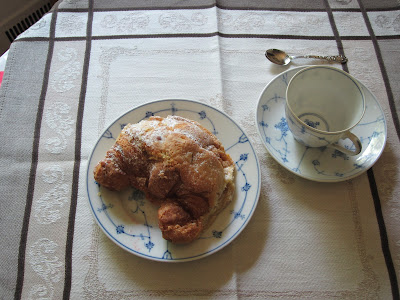Nice, France
The last stop on our trip to France was Nice. I really liked Nice and would go back if I have a chance to do so. Partly, I think, it is the combination of water and sunshine. The water is such a beautiful a color unlike anything I have ever seen, even in Hawaii, which was my favorite until Nice. The hotel was only a couple of blocks from the Promenade making it easy to walk to and sit on a bench soaking up the sun and enjoying the surf. It was too cool for many people to be on the beach, therefore, relatively quiet and very pleasant. There was even a fisherman out in the bay.
The streets are narrow and most of the buildings in the city are painted shades of yellow or orange with red tiled roofs. The traditional colors for Nice are orange and green so many of the buildings also had green shutters on the windows. It is not far from Italy and the flower market has a wonderful mix of French and Italian.
Street scene, Nice
[photo: courtesy of the Gimlets]
I stayed in Nice the day the rest of the group went to the perched village of Eze since the tour guide had said that it was a steep climb with lots of stairs and once again she wanted to park me in a café while the others walked up to the top of the mountain. That was not what I wanted to do. I decided to take a nap, walk to the beach and then to the flower market, do a little shopping and get ice cream. It was a good choice for me.
One of several restaurants in the flower market
Flower Market
The flower market does indeed have flowers and lots of them but is also
sort of an open-air general market with all kinds of fruits, vegetables,
seafood, restaurants and crafts. It was a good place to just wander
around looking at things and I found some lovely watercolor paintings
that made the day a success. Now I just wish I could read the artist’s
name and somehow get in touch with him, as I would happily buy other
things from him.
There are many things to see and do in Nice. Even though we had some free time it wasn’t enough to really take in the museums and other attractions. I would like to have visited both the Musée Matisse and the Musée Chagall.
One of the things I did not get a picture of was the decorated palm trees in front of one of the large hotels along the Promenade. The city seemed at times to have an almost carnival air to it. The palms had colored tinsel like Christmas trees that glittered at night. Some of the streets had overhead white, blue and purple LED lights strung across not noticeable during the day very pretty at night.
There are many things to see and do in Nice. Even though we had some free time it wasn’t enough to really take in the museums and other attractions. I would like to have visited both the Musée Matisse and the Musée Chagall.
One of the things I did not get a picture of was the decorated palm trees in front of one of the large hotels along the Promenade. The city seemed at times to have an almost carnival air to it. The palms had colored tinsel like Christmas trees that glittered at night. Some of the streets had overhead white, blue and purple LED lights strung across not noticeable during the day very pretty at night.
Would I go back to France? Absolutely. I loved everything from the places to the people to the food and more.












































